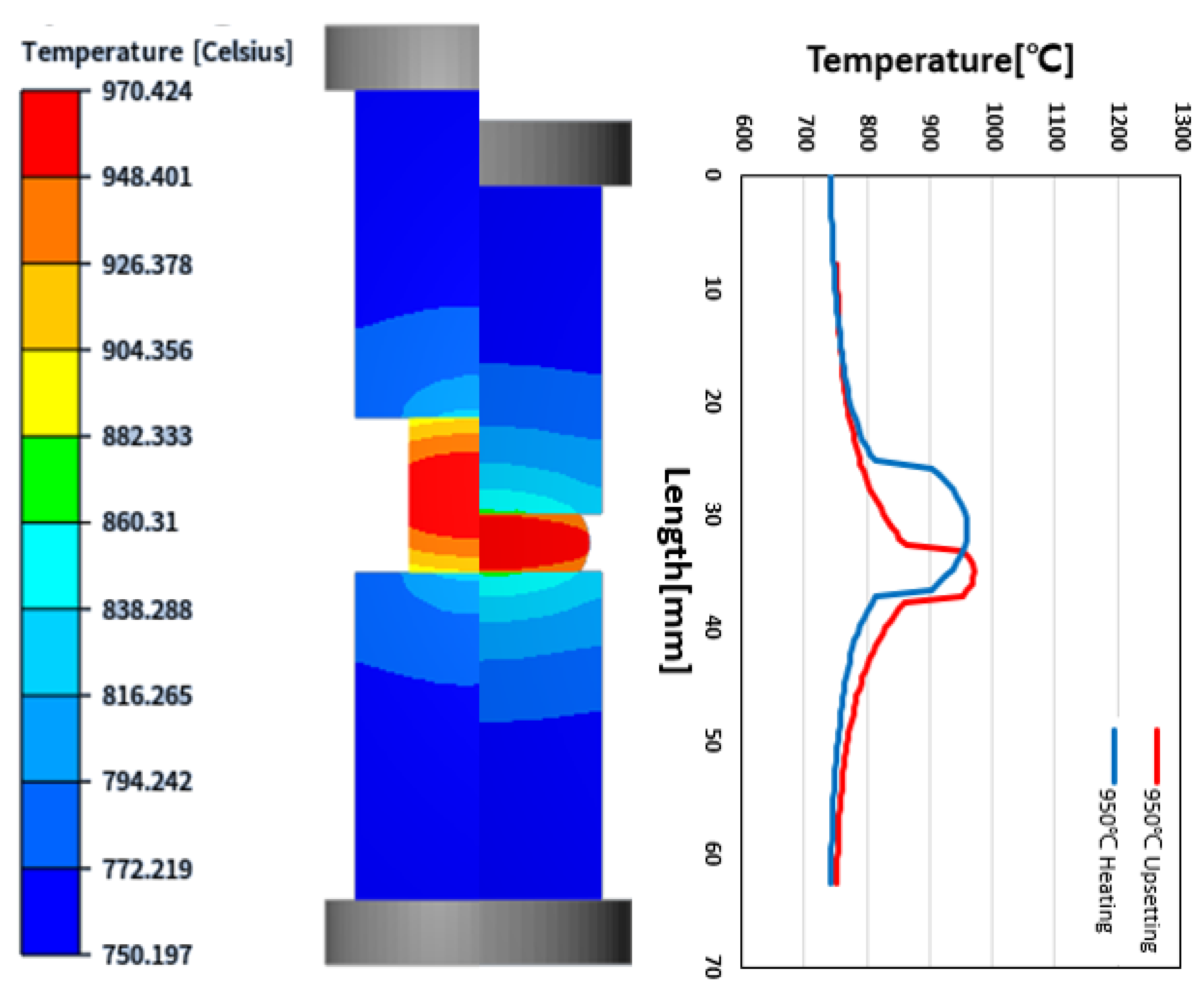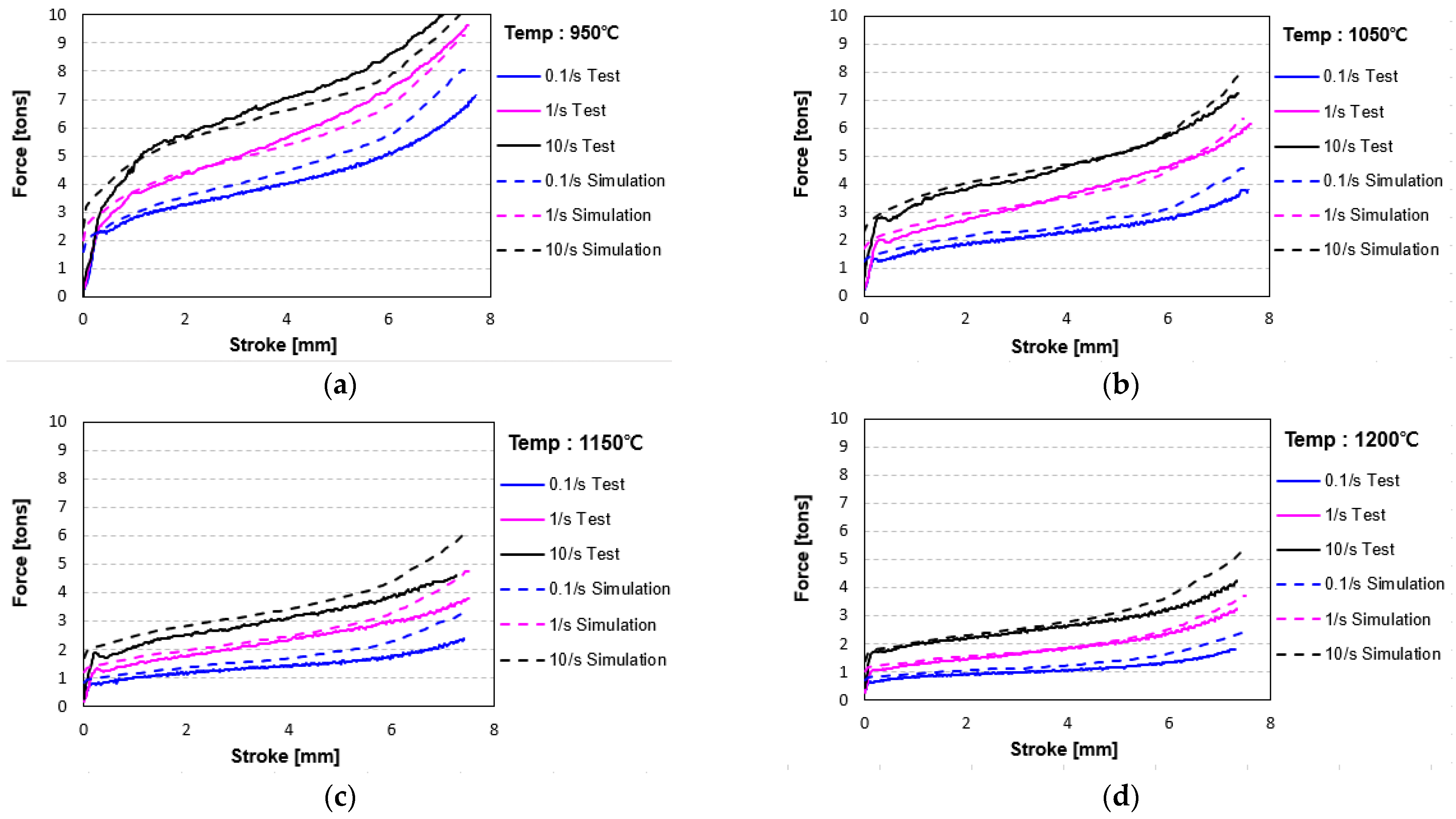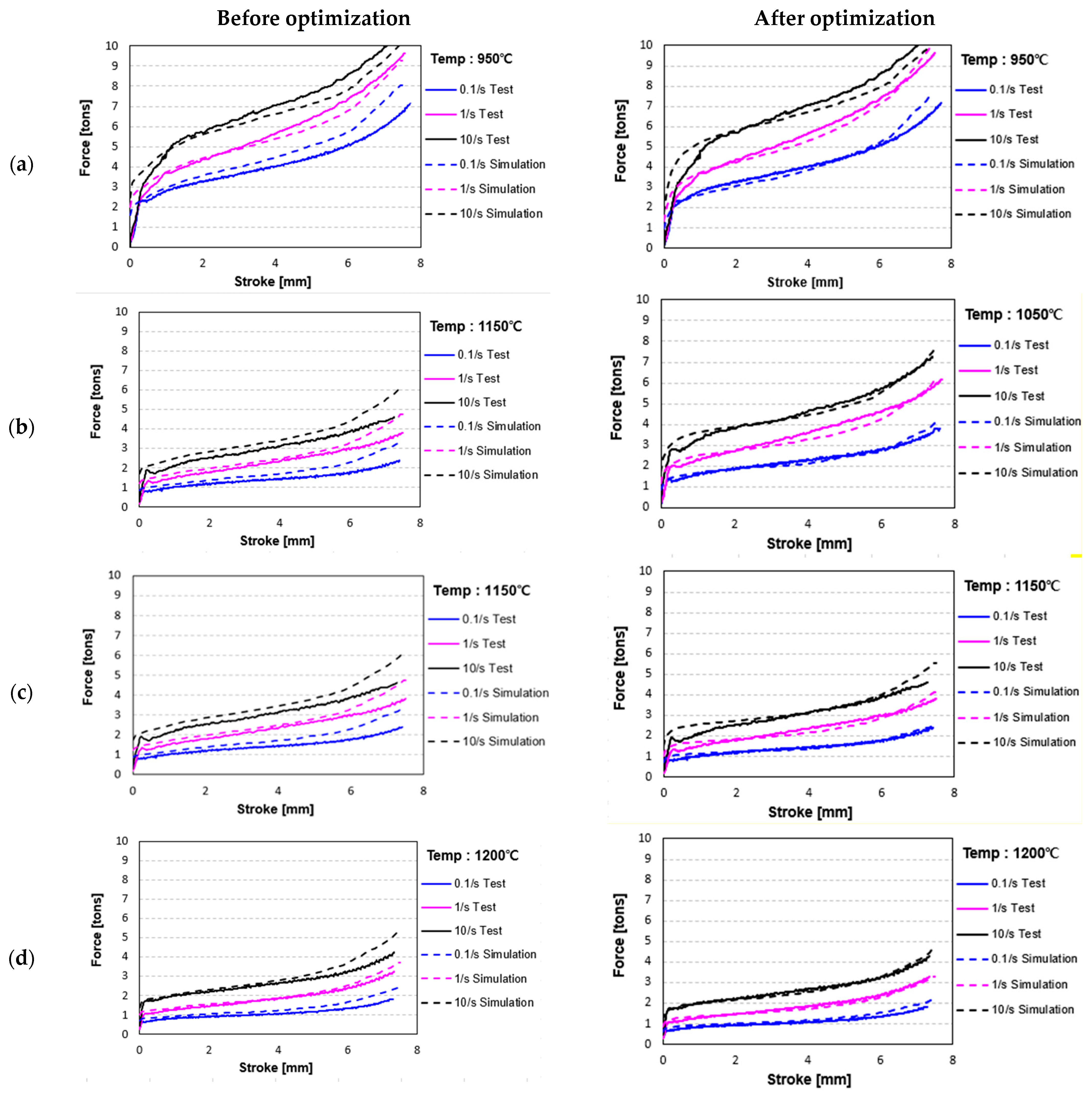Flow Stress Optimization of Inconel 718 Based on a Coupled Simulation of Material-Forming Analysis and Joule Heating Analysis
Abstract
:1. Introduction
2. Hot Compression Test
3. Electrical Heating Simulation of Inconel 718
4. Optimization of Parameters in the Hansel–Spittel Equation
4.1. Comparison of Experimental and Analysis Results before Flow Stress Optimization
4.2. Comparison of Experimental and Analysis Results after Flow Stress Optimization
5. Conclusions
- (1)
- The electrical Joule heating results showed that there was a significant temperature difference between the temperature measurement point and the interface between the specimen and the die. When the deformation temperature was 950 °C, the temperature difference was as large as 70 °C. This means that accurately estimating the flow stress requires analysis of the heating process as well, in addition to the subsequent upsetting analysis.
- (2)
- The optimized flow stress was lower than the calculated value based on the experimental data, and the difference became larger as the deformation temperature increased. This was attributed to the larger difference in temperature between the temperature measurement point and the interface between the specimen and the die at higher deformation temperatures, resulting from Joule heating. This led to a larger deviation from the average temperature of the entire volume of the specimen.
- (3)
- The root mean square error (RMSE) was calculated to quantify the error of the simulation results before and after optimization. Overall, despite the exception under the conditions of 950 °C 10/s and 1050 °C 1/s where the RMSE increased inversely, the RMSE improved by 34.8% on average after optimization, confirming the validity of the optimization process based on Joule heating analysis proposed in the present study.
Author Contributions
Funding
Institutional Review Board Statement
Informed Consent Statement
Data Availability Statement
Conflicts of Interest
References
- Iturbe, A.; Giraud, E.; Hormaetxe, E.; Garay, A.; Germain, G.; Ostolaza, K.; Arrazola, P.J. Mechanical characterization and modelling of Inconel 718 material behavior for machining process assessment. Mater. Sci. Eng. A 2017, 682, 441–453. [Google Scholar] [CrossRef] [Green Version]
- Jonas, J.J.; Sellars, C.M.; Tegart, W.J.M. Strength and structure under hot-working conditions. Metall. Rev. 1969, 14, 1–24. [Google Scholar] [CrossRef]
- Johnson, G.R.; Cook, W.H. Fracture Characteristics of Three Metals Subjected to Various Strains, Strain rates, Temperatures and Pressures. Eng. Frac. Mech. 1985, 21, 31–48. [Google Scholar] [CrossRef]
- Hensel, A.; Spittel, T. Kraft-Und Arbeitsbedarf Bildsamer Formgebungsverfahren, 1st ed.; VEB Deutscher Verlag Für Grundstoffindustrie: Leipzig, Germany, 1978. [Google Scholar]
- Zerille, F.J.; Armstrong, R.W. Dislocation-mechanics-based constitutive relations for material dynamics calculations. J. Appl. Phys. 1987, 61, 1816–1825. [Google Scholar] [CrossRef] [Green Version]
- Khan, A.S.; Liang, R. Behaviors of three BCC metal over a wide range of strain rates and temperatures: Experiments and modeling. Int. J. Plast. 1999, 15, 1089–1109. [Google Scholar] [CrossRef]
- Rao, K.P.; Prasad, Y.K.D.V.; Hawbolt, E.B. Hot deformation studies on a low-carbon steel: Part 1—Flow curves and the constitutive relationship. J. Mater Process Technol. 1996, 56, 897–907. [Google Scholar] [CrossRef]
- Zou, D.N.; Wu, K.; Han, Y.; Zhang, W.; Cheng, B.; Qiao, G.J. Deformation characteristic and prediction of flow stress for as-cast 21Cr economical duplex stainless steel under hot compression. Mater. Des. 2013, 51, 975–982. [Google Scholar] [CrossRef]
- Kang, J.h.; Heo, S.j.; Yoo, J.; Kwon, Y.C. Hot working characteristics of S32760 super duplex stainless steel. J. Mech. Sci. Technol. 2019, 33, 2633–2640. [Google Scholar] [CrossRef]
- Detrois, M.; Antonov, S.; Tin, S.; Jablonski, P.D.; Hawk, J.A. Hot deformation behavior and flow stress modeling of a Ni-based superalloy. Mater. Charact. 2019, 157, 109915. [Google Scholar] [CrossRef]
- Lizzi, F.; Pradeep, K.; Stanojevic, A.; Sommadossi, S.; Poletti, M.C. Hot Deformation Behavior of a Ni-Based Superalloy with Suppressed Precipitation. Metals 2021, 11, 605. [Google Scholar] [CrossRef]
- Grzesik, W.; Nieslony, P.; Laskowski, P. Determination of Material Constitutive Laws for Inconel 718 Superalloy Under Different Strain Rates and Working Temperatures. J. Mater. Eng. Perform. 2017, 26, 5705–5714. [Google Scholar] [CrossRef] [Green Version]
- Park, K.B.; Cho, Y.T.; Jung, Y.G. Determination of Johnson-Cook constitutive equation for Inconel 601. J. Mech. Sci. Technol. 2018, 32, 1569–1574. [Google Scholar] [CrossRef]
- Storchak, M.; Rupp, P.; Moehring, H.C.; Stehle, T. Determination of Johnson–Cook Constitutive Parameters for Cutting Simulations. Metals 2019, 9, 473. [Google Scholar] [CrossRef] [Green Version]
- Liang, Q.; Liu, X.; Li, P.; Ding, P.; Zhang, X. Development and Application of High-Temperature Constitutive Model of HNi55-7-4-2 Alloy. Metals 2020, 10, 1250. [Google Scholar] [CrossRef]
- Wang, H.; Wang, W.; Zhai, R.; Ma, R.; Zhao, J.; Mu, Z. Constitutive Equations for Describing the Warm and Hot Deformation Behavior of 20Cr2Ni4A Alloy Steel. Metals 2020, 10, 1169. [Google Scholar] [CrossRef]
- Peng, X.; Guo, H.; Shi, J.; Qin, C.; Zhao, Z. Constitutive equations for high temperature flow stress of TC4-DT alloy incorporating strain, strain rate and temperature. Mater. Des. 2013, 50, 198–206. [Google Scholar] [CrossRef]
- Yin, F.; Hua, L.; Mao, H.; Han, X. Constitutive modeling for flow behavior of GCr15 steel under hot compression experiments. Matcer. Des. 2013, 43, 393–401. [Google Scholar] [CrossRef]
- Ge, G.; Zhang, L.; Xin, J.; Lin, J.; Aindow, M.; Zhang, L. Constitutive modeling of high temperature flow behavior in a Ti-45Al-8Nb-2Cr-2Mn-0.2Y alloy. Sci. Report. 2018, 8, 1–9. [Google Scholar] [CrossRef] [Green Version]
- Xu, S.; Shu, X.; Li, S.; Chen, J. Flow Stress Curve Modification and Constitutive Model of 20CrMoA Steel during Warm Deformation. Metals 2020, 10, 1602. [Google Scholar] [CrossRef]
- Sekar, K.S.; Kumar, M.P. Optimising Flow Stress Input for Machining Simulations Using Taguchi Methodology. Int. J. Simul. Model. 2012, 11, 17–28. [Google Scholar] [CrossRef]
- Niu, L.; Zhang, Q.; Wang, B.; Han, B.; Li, H.; Mei, T. A modified Hansel-Spittel constitutive equation of Ti-6Al-4V during cogging process. J. Alloys Compd. 2022, 894, 162387. [Google Scholar] [CrossRef]
- Chen, X.; Du, Y.; Du, K.; Lian, T.; Liu, B.; Li, Z.; Zhou, X. Identification of the Constitutive Model Parameters by Inverse Optimization Method and Characterization of Hot Deformation Behavior for Ultra-Supercritical Rotor Steel. Materials 2021, 14, 1958. [Google Scholar] [CrossRef]
- Mirzaie, T.; Mirzadeh, H.; Cabrera, J.M. A simple Zerilli–Armstrong constitutive equation for modeling and prediction of hot deformation flow stress of steels. Mech. Mater. 2016, 94, 38–45. [Google Scholar] [CrossRef] [Green Version]
- Mahalle1, G.; Salunke1, O.; Kotkunde1, N.; Gupta1, A.K.; Singh, S.K. Study of Khan-Huang-Liang (KHL) Anisotropic Deformation Model for Deep Drawing Behaviour of Inconel 718 Alloy. IOP Conf. Ser. Mater. Sci. Eng. 2020, 967, 012054. [Google Scholar] [CrossRef]
- Piao, M.; Huh, H.; Lee, I.; Ahn, K.; Kim, H.; Park, L. Characterization of flow stress at ultra-high strain rates by proper extrapolation with Taylor impact tests. Int. J. Impact Eng. 2016, 91, 142–157. [Google Scholar] [CrossRef]
- Wang, F.; Zhao, J.; Zhu, N. Constitutive Equations and ANN Approach to Predict the Flow Stress of Ti-6Al-4V Alloy Based on ABI Tests. J. Mater. Eng. Perform. 2016, 25, 4875–4884. [Google Scholar] [CrossRef]
- Shang, H.; Wu, P.; Lou, Y.; Wang, J.; Chen, Q. Machine learning-based modeling of the coupling effect of strain rate and temperature on strain hardening for 5182-O aluminum alloy. J. Mater. Proc. Tech. 2022, 302, 117501. [Google Scholar] [CrossRef]
- Li, X.; Roth, C.C.; Mohr, D. Machine-learning based temperature- and rate-dependent plasticity model: Application to analysis of fracture experiments on DP steel. Int. J. Plast. 2019, 118, 320–344. [Google Scholar] [CrossRef]
- Men, Z.; Wang, M.; Ma, Y.; Yue, T.; Liu, R. Application of Direct Resistance Heating in Hot Forging and Analysis of Processing Parameters based on Thermo-electro-mechanical Coupling FEM. High Temp. Mater. Process. 2018, 37, 531–538. [Google Scholar]
- Thangaraju, S.K.; Munisamy, K.M. Electrical and Joule heating relationship investigation using Finite Element Method. IOP Conf. Ser. Mater. Sci. Eng. 2015, 88, 012036. [Google Scholar] [CrossRef] [Green Version]
- Fan, Y.H.; Wang, T.; Hao, Z.P.; Liu, X.Y.; Gao, S.; Li, R.L. Surface residual stress in high speed cutting of superalloy Inconel718based on multiscale simulation. J. Manuf. Proc. 2018, 31, 480–493. [Google Scholar] [CrossRef]











| Parameter | Min. | Max. | 950 °C | 1050 °C | 1150 °C | 1200 °C |
|---|---|---|---|---|---|---|
| A | 2000 | 3000 | 2640.9 | 1746.9 | 1458.2 | 1390.0 |
| m1 | −0.02 | −0.001 | −0.00196 | −0.00193 | −0.00197 | −0.00197 |
| m2 | −0.2 | −0.001 | −0.1036 | −0.1378 | −0.1711 | −0.1382 |
| m3 | 0.15 | 0.25 | 0.15 | 0.1692 | 0.1788 | 0.1567 |
| m4 | −0.05 | −0.005 | −0.023 | −0.0197 | −0.0161 | −0.0150 |
| Temp. (°C) | Strain Rate (/s) | RMS of Error (MPa) | Difference (MPa) | Improvement Rate (%) | |
|---|---|---|---|---|---|
| Not Optimized | Optimized | ||||
| 950 | 0.1 | 0.5481 | 0.2388 | 0.3093 | 56.4 |
| 1 | 0.3189 | 0.2927 | 0.0262 | 8.2 | |
| 10 | 0.4961 | 0.5132 | −0.0171 | −7.8 | |
| 1050 | 0.1 | 0.3380 | 0.1167 | 0.2213 | 65.5 |
| 1 | 0.2035 | 0.2520 | −0.0485 | −23.8 | |
| 10 | 0.4033 | 0.3672 | 0.0361 | 8.9 | |
| 1150 | 0.1 | 0.3470 | 0.0749 | 0.2721 | 78.4 |
| 1 | 0.2702 | 0.1728 | 0.0974 | 36.0 | |
| 10 | 0.4312 | 0.2390 | 0.1922 | 44.6 | |
| 1200 | 0.1 | 0.2201 | 0.1304 | 0.0897 | 40.8 |
| 1 | 0.1252 | 0.0990 | 0.0262 | 20.9 | |
| 10 | 0.5546 | 0.2786 | 0.2760 | 49.8 | |
| Summary | 4.2562 | 2.7753 | 1.4809 | 34.8 | |
Publisher’s Note: MDPI stays neutral with regard to jurisdictional claims in published maps and institutional affiliations. |
© 2022 by the authors. Licensee MDPI, Basel, Switzerland. This article is an open access article distributed under the terms and conditions of the Creative Commons Attribution (CC BY) license (https://creativecommons.org/licenses/by/4.0/).
Share and Cite
Park, J.-S.; Kim, S.-W.; Lim, H.-C.; Kang, J.-H. Flow Stress Optimization of Inconel 718 Based on a Coupled Simulation of Material-Forming Analysis and Joule Heating Analysis. Metals 2022, 12, 2024. https://doi.org/10.3390/met12122024
Park J-S, Kim S-W, Lim H-C, Kang J-H. Flow Stress Optimization of Inconel 718 Based on a Coupled Simulation of Material-Forming Analysis and Joule Heating Analysis. Metals. 2022; 12(12):2024. https://doi.org/10.3390/met12122024
Chicago/Turabian StylePark, Jong-Soo, Seung-Woo Kim, Hyung-Cheol Lim, and Jong-Hun Kang. 2022. "Flow Stress Optimization of Inconel 718 Based on a Coupled Simulation of Material-Forming Analysis and Joule Heating Analysis" Metals 12, no. 12: 2024. https://doi.org/10.3390/met12122024






